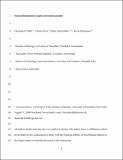Files in this item
Social information in equine movement gestalts
Item metadata
| dc.contributor.author | Dahl, Christoph D. | |
| dc.contributor.author | Wyss, Christa | |
| dc.contributor.author | Zuberbuhler, Klaus | |
| dc.contributor.author | Bachmann, Iris | |
| dc.date.accessioned | 2019-05-23T12:34:39Z | |
| dc.date.available | 2019-05-23T12:34:39Z | |
| dc.date.issued | 2018-05-23 | |
| dc.identifier | 253160530 | |
| dc.identifier | 6e6ed9ba-d20a-45e8-8297-66b8d9137933 | |
| dc.identifier | 85047263820 | |
| dc.identifier | 000435587400011 | |
| dc.identifier.citation | Dahl , C D , Wyss , C , Zuberbuhler , K & Bachmann , I 2018 , ' Social information in equine movement gestalts ' , Animal Cognition , vol. In press . https://doi.org/10.1007/s10071-018-1193-z | en |
| dc.identifier.issn | 1435-9448 | |
| dc.identifier.other | ORCID: /0000-0001-8378-088X/work/64360657 | |
| dc.identifier.uri | https://hdl.handle.net/10023/17746 | |
| dc.description | This study was funded via the Ambizione Fellowship of the Swiss National Science Foundation (SNSF) (PZ00P3_154741) awarded to CDD and by project funding of the Swiss National Science Foundation (31003A_166458) awarded to KZ. | en |
| dc.description.abstract | One model of signal evolution is based on the notion that behaviours become increasingly detached from their original biological functions to obtain a communicative value. Selection may not always favour the evolution of such transitions, for instance, if signalling is costly due to predators usurping signal production. Here, we collected inertial movement sensing data recorded from multiple locations in free-ranging horses (Equus caballus), which we subjected to a machine learning algorithm to extract kinematic gestalt profiles. This yielded surprisingly rich and multi-layered sets of information. In particular, we were able to discriminate identity, breed, sex and some personality traits from the overall movement patterns of freely moving subjects. Our study suggests that, by attending to movement gestalts, domestic horses, and probably many other group-living animals, have access to rich social information passively but reliably made available by conspecifics, a finding that we discuss in relation with current signal evolution theories. | |
| dc.format.extent | 966626 | |
| dc.language.iso | eng | |
| dc.relation.ispartof | Animal Cognition | en |
| dc.subject | Animal communication | en |
| dc.subject | Movement gestalt | en |
| dc.subject | Signal evolution | en |
| dc.subject | Phylogenetic ritualization | en |
| dc.subject | Horse cognition | en |
| dc.subject | BF Psychology | en |
| dc.subject | QL Zoology | en |
| dc.subject | NDAS | en |
| dc.subject.lcc | BF | en |
| dc.subject.lcc | QL | en |
| dc.title | Social information in equine movement gestalts | en |
| dc.type | Journal article | en |
| dc.contributor.institution | University of St Andrews. School of Psychology and Neuroscience | en |
| dc.contributor.institution | University of St Andrews. Institute of Behavioural and Neural Sciences | en |
| dc.contributor.institution | University of St Andrews. Centre for Social Learning & Cognitive Evolution | en |
| dc.identifier.doi | 10.1007/s10071-018-1193-z | |
| dc.description.status | Peer reviewed | en |
| dc.date.embargoedUntil | 2019-05-23 |
This item appears in the following Collection(s)
Items in the St Andrews Research Repository are protected by copyright, with all rights reserved, unless otherwise indicated.

